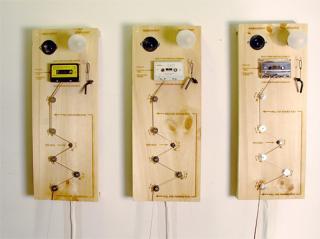Tape Translations
Emily Webster
Genevieve Hoffman
Ju Yun Song
Tape Translations demystifies analog sound by allowing visitors to "play" cassette tapes by hand. The encoded sound information on the tape is also translated into light.
www.tapetranslations.com

What does sound mean? What does it mean to read music? How does modern technology actually work? These were questions which launched our exploration into the world of analog sound. Tape Translations begins to demystify how our devices "play" music by allowing visitors to take an active role in the playback process. As music and sound continues to move into the digital era, our nostalgia with more archaic forms of music production increases. The installation strives to show viewers that the magnetic information stored on the ribbon in the cassette tape can be read in a variety of "languages." Historically, we have read this ribbon of information in the language of audio but the installation shows how we can also translate that information into light. This type of display, we hope, allows the viewers to imagine what other languages the magnetic tape could be translated into…light, graphics, movement or sound.
Background
A fascination with analog playback devices that are slowly being replaced by digital technologies. And this: http://www.switched.com/2010/10/22/sony-walkman-dead-in-japan-we-pour-one-out-for-the-cas/
Audience
All ages!
User Scenario
Tape Translations is a modular, wall mounted, interactive sound exhibit. Participants approach a mounted panel to which a cassette tape, speaker and light bulb have been affixed. The tape's ribbon has been pulled from its plastic casing and runs around a series of bobbins and across a magnetic tape head. The user is prompted to grab and pull the loose tape through the system. As the tape runs over the sensor, the magnetic information encoded on the tape is played through the speaker and distorted based upon the speed at which the user is pulling. The magnetic information is also translated into a different form, turning on a light bulb, which reflects the varying voltage levels of the magnetic information. Each panel contains one tape system, however the combination of multiple visitors pulling multiple tapes creates a composition of sound which becomes more robust as more "players" are present.
Implementation
The panels are made of pine wood with instructions for the user laser etched onto the surface. Each panel contains a set of speakers, a series of bobbins, a play head and a hacked LED light bulb.
Conclusion
We learned a lot about how information is encoded on the tape ribbon and subsequently played back to a listener. We hacked walkmen to use their tape heads, pulled apart cassette tapes for their ribbon and investigated the possibilities of reading other media such as VHS tapes.
Background
A fascination with analog playback devices that are slowly being replaced by digital technologies. And this: http://www.switched.com/2010/10/22/sony-walkman-dead-in-japan-we-pour-one-out-for-the-cas/
Audience
All ages!
User Scenario
Tape Translations is a modular, wall mounted, interactive sound exhibit. Participants approach a mounted panel to which a cassette tape, speaker and light bulb have been affixed. The tape's ribbon has been pulled from its plastic casing and runs around a series of bobbins and across a magnetic tape head. The user is prompted to grab and pull the loose tape through the system. As the tape runs over the sensor, the magnetic information encoded on the tape is played through the speaker and distorted based upon the speed at which the user is pulling. The magnetic information is also translated into a different form, turning on a light bulb, which reflects the varying voltage levels of the magnetic information. Each panel contains one tape system, however the combination of multiple visitors pulling multiple tapes creates a composition of sound which becomes more robust as more "players" are present.
Implementation
The panels are made of pine wood with instructions for the user laser etched onto the surface. Each panel contains a set of speakers, a series of bobbins, a play head and a hacked LED light bulb.
Conclusion
We learned a lot about how information is encoded on the tape ribbon and subsequently played back to a listener. We hacked walkmen to use their tape heads, pulled apart cassette tapes for their ribbon and investigated the possibilities of reading other media such as VHS tapes.


